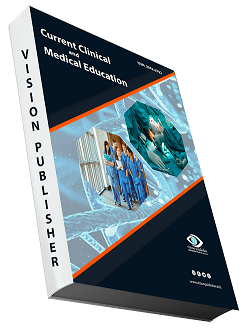Evaluation of drug resistance in clinical isolates of klebsiella species
Abstract
Clinically significant, consecutive, non-duplicate isolates were included in the study. The
significance of the isolate was based on two or more of the following criteria-clinical history,
presence of organism in Gram stain, presence of intracellular forms of the organism and pure
growth in cuture with a significant colony count wherever applicable. A total of 200 clinically
significant, consecutive, non-duplicate isolates of Klebsiella spp. were included in this study. The
isolates were from various clinical specimens sent to the Institute of Microbiology for
bacteriological culture, biochemical identification and antibiotic susceptibility testing. Isolates
included in this study were obtained from blood, sputum, endotracheal aspirate, bronchial wash,
pleural fluid, ascitic fluid, peritoneal dialysis fluid, cerebrospinal fluid, urine and wound swabs.
Keywords: Klebsiella, isolation, culture specimen, growth of organism.
Downloads
References
Waksman SA, Woodruff HB. The Soil as a Source of Microorganisms Antagonistic to Disease-Producing Bacteria. J Bacteriol 1940;40:581-600.
CDC Gram negative bacteria And Antimicrobial resistant.
Brisse, S., Grimont, F., Grimont, P.A.D. 2006. The genus Klebsiella. In: Dworkin, M., Falkow, S., Rosenberg, E., Schleifer, K.-H., Stackebrandt, E. (Eds), The prokaryotes. A handbook on the biology of bacteria, 3rd edn. Springer, NewYork. Pp. 159–196.
Peleg, A.Y., Hooper, D.C. 2010. Hospital-acquired infections due to gramnegative bacteria. N. Engl. J. Med., 362: 1804–13.
Murray PR, Rosenthal KS, Pfaller MA. Medical microbiology. 5th edition.
Philadelphia: Elsevier/Saunders; 2003.
Podschun, R., Ullmann, U. 1998. Klebsiella spp. As nosocomial pathogens: epidemiology, taxonomy, typing methods, and pathogenicity factors. Clin. Microbiol. Rev., 11(4): 589–603.
Jadhav, S., Misra, R., Gandham, N., Ujagare, M., Ghosh, P., Angadi, K., et al. 2012. Increasing incidence of multidrug resistance Klebsiella pneumonia. Infections in hospital and community settings. Int. J. Microbiol. Res., 4(6):
–257.
Topley WWC. Microbiology and microbial infections.Tenth edition. London: Hodder Arnold; 2005.
Greenwood D, Barer M, Slack R, Irving W. Medical microbiology. Eighteenth edition. Edinburgh: Churchill Livingstone/Elsevier; 2012.
Shampo MA, Kyle RA. Ernst Chain--Nobel Prize for work on penicillin. Mayo Clin Proc 2000; 75:882.
Livermore DM. β-Lactamases in Laboratory and Clinical Resistance. Clin Microbiol Rev 1995; 8:557.
Mathew A, Harris AM, Marshall MJ, Ross GW. The use of analytical isoelectric focusing for detection and identification of beta-lactamases. J Gen Microbiol 1975; 88:169-78.
Jack GW, Richmond MH. A comparative study of eight distinct betalactamases synthesized by gram-negative bacteria. J Gen Microbiol 1970;
:43-61.
CLSI. Performance Standards for Antimicrobial Susceptibility Testing, Twentieth Informational Supplement, CLSI Document M100-S20, Wayne, PA: Clinical and Laboratory Standards Institute, 2016.
Kliebe C, Nies BA, Meyer JF, Tolxdorff-Neutzling RM, Wiedemann B. Evolution of plasmid-coded resistance to broad-spectrum cephalosporins. Antimicrob Agents Chemother 1985; 28:302-7.
Sanders CC, Sanders WE Jr. Type I beta-lactamases of gram-negative bacteria: interactions with beta-lactam antibiotics. J Infect Dis 1986;154:792- 800.
Bush, K. ß-Lactamase Inhibitors from Laboratory to Clinic. Clin Microbiol Rev 1998; 1:109-23.
Brooks GF, Jawetz E, Melnick JL, & Adelberg EA. Jawetz, Melnick, & Adelberg's medical microbiology. 26th edition. New York: McGraw Hill Medical; 2010.
Clatworthy, Anne E.; Pierson, Emily; Hung, Deborah T. Targeting virulence: a new paradigm for antimicrobial therapy. Nature Chemical Biology, 2007. 3; 541-548.
Spellberg, Brad; et al. Trends in antimicrobial drug development: implications for the future. Clinical Infectious Diseases, 2004. 38(9); 1279-
Magill, Shelley S; et al. Multistate point-prevalence survey of health care associated infections. New England Journal of Medicine, 2014. 370(3); 1198 1208.
Podschun, Rainer; Ullmann, U. Klebsiella spp. As nosocomial pathogens: epidemiology, taxonomy, typing methods, and pathogenicity factors. Clinical Microbiology Reviews, 1998. 11(4); 589-603.
Arnold, Ryan S; et al. Emergence of Klebsiella pneumoniae carbapenemase (KPC) producing bacteria. Southern Medical Journal, 2011. 104(1); 40-45.
Nordmann, Patrice; Cuzon, Gaelle; Naas, Thierry. The real threat of Klebsiella pneumoniae carbapenemase-producing bacteria. The Lancet Infectious Diseases, 2009. 9(4); 228-236.
Yong, Dongeun; Toleman, Mark A.; Giske, Christian G.; Cho, Hyun S.; Sundman, Kristina; Lee, Kyungwon; Walsh, Timothy R. Characterization of a new metallobeta- lactamase gene, bla(NDM-1), and a novel erythromycin
sterase gene carried on a unique genetic structure in Klebsiella pneumonia sequence type 14 from India. Antimicrobial agents and chemotherapy, 2009. 53(12); 5046-5054.
Rasheed, Kamile; et al. New Delhi metallo-β-lactamase-producing Enterobacteriaceae, United States. Emerging Infectious Diseases, 2013.
(6).
Borer, Abraham; Saidel-Odes, Lisa; Riesenberg, Klaris; Eskira, Seada; Peled,
Nejama; Nativ, Ronit; Schlaeffer, Fracise; Sherf, Michael. Attributable mortality rate for carbapenem-resistant Klebsiella pneumoniae bacteremia. Infection Control & Hospital Epidemiology, 2009. 30(10); 972-976.
Gupta, Neil; Limbago, Brandi M.; Patel, Jean B.; Kallen, Alexander J. Carbapenemresistant Enterobacteriaceae: epidemiology and prevention. Clinical Infectious Diseases, 2011. 53(1); 60-67.
Shon, Alyssa S.; Bajwa, Rajinder P.S.; Russo, Thomas A. Hypervirulent (hypermucoviscous) Klebsiella pneumoniae. Virulence, 2013. 4(2); 107-118.
Wu, Keh-Ming; et al. Genome sequencing and comparative analysis of Klebsiella pneumoniae NTUH-K2044, a strain causing liver abscess and
meningitis. Journal of Bacteriology, 2009. 191(14); 4492-4501.
Arakawa, Yoshichika; et al. Genomic organization of the Klebsiella pneumoniae cps region responsible for serotype K2 capsular polysaccharide synthesis in the virulent strain Chedid. Journal of Bacteriology, 1995. 177(7);
-1796.
Fang, Chi-Tai; Chuang, Yi-Ping; Shun, Chia-Tung; Chang, Shan-Chwen; Wang, Jin- Town. A novel virulence gene in Klebsiella pneumoniae strains causing primary liver abscess and septic metastatic complications. Journal of Experimental Medicine, 2004. 199(5); 697-705.
Domenico, Philip; Salo, Richard J.; Cross, Alan S.; Cunha, Burke A. Polysaccharide capsule-mediated resistance to opsonophagocytosis in .
Infection and Immunity, 1994. 62(10); 4495-4499.
Chhibber, Sanjay; Aggarwal, S.; Yadav, V. Contribution of capsular and lipopolysaccharide antigens to the pathogenesis of Klebsiella pneumonia respiratory tract infection. Folia Microbiologia, 2003. 48(5); 699-702.
Proft, T.; Baker, E.N. Pili in gram-negative and gram-positive bacteria – structure, assembly and their role in disease. Cellular and Molecular Life
Sciences, 2009. 66(4); 613-635.
Fader, Robert C.; Avots-Avotins, Andrejs E.; Davis, Charles P. Evidence of pili-mediated adherence of Klebsiella pneumoniae to rat bladder epithelial cells in-vitro. Infection and Immunity, 1979. 25(2); 729-37.
Fader, Robert C.; Gondesen, Kelli; Tolley, Brooks, Ritchie David G.; Moller, Peter. Evidence that in vitro adherence of Klebsiella pneumoniae to ciliated hamster tracheal cells is mediated by type 1 fimbriae. Infection and Immunity, 1988. 56(11); 3011-3013.
Bodelon, Gustavo; Palomino, Carmen; Fernandez, Luis A. Immunoglobulin domains in Escherichia coli and other enterobacteria: from pathogenesis to applications in antibody technologies. FEMS Microbiology Reviews, 2013.
(2); 204-250.
Hornick, Douglas; Allen, Bradley L.; Horn, Mark A.; Clegg, Steven. Adherence to respiratory epithelia by recombinant Escherichia coli expressing Klebsiella pneumoniae fimbrial gene product. Infection and Immunity, 1992. 60(4); 1577-1588.
Jagnow, Jennifer; Clegg, Steven. Klebsiella pneumoniae MrkD-mediated biofilm formation on extracellular matrix and collagen coated surfaces. Microbiology, 2003. 149(9); 2397-2405.
Hennequin, Claire; Forestier, Christiane. Influence of capsule and extendedspectrum
beta-lactamases encoding plasmids upon Klebsiella pneumonia adhesion. Research in Microbiology, 2007. 158(4); 339-347.
Martino, Patrick D.; et al. Molecular characterization and adhesive properties of CF29K, an adhesion of Klebsiella pneumoniae strains involved in nosocomial infections. Infection and Immunity, 1995. 63(11); 4336-4344.
Downloads
Published
How to Cite
Issue
Section
License

This work is licensed under a Creative Commons Attribution 4.0 International License.
Current Clinical and Medical Education













